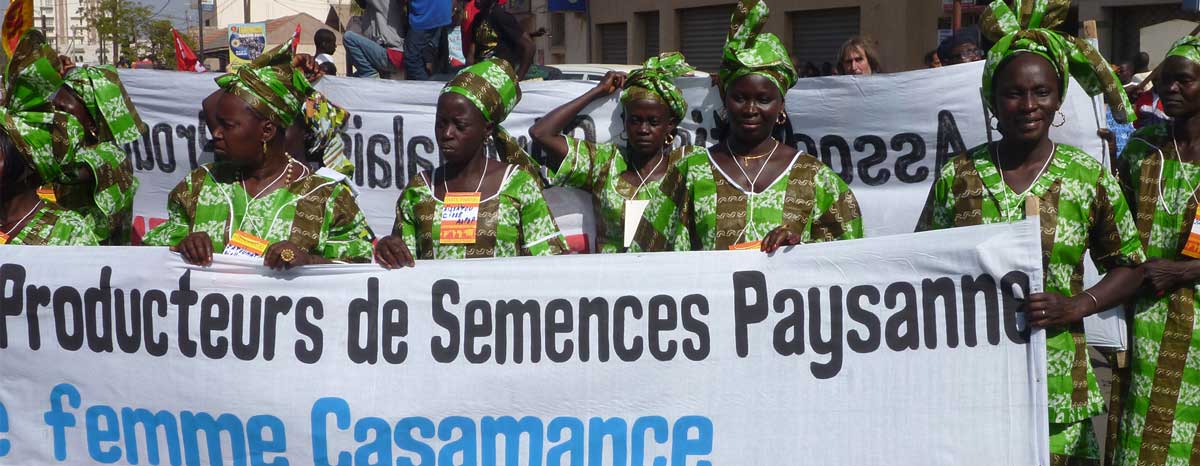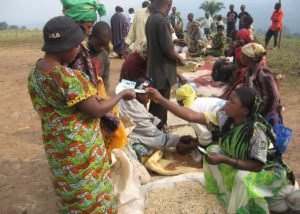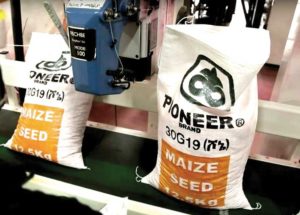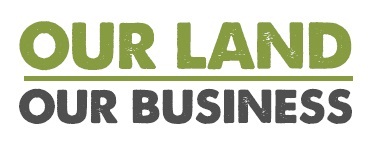Reformed World Bank Program Still Fails the Farmers

Women farmer organizations march to defend farmer seeds at the 2011 World Social Forum in Dakar. Copyright Awa Tounkara
In 2013, the World Bank launched the Enabling the Business of Agriculture (EBA) project, aimed at guiding pro-business reforms in the agriculture sector. It was initially commissioned to support the New Alliance for Food Security and Nutrition, an initiative launched by the G8 to promote private sector-led agricultural development in Africa.
Financed by the Bill and Melinda Gates Foundation, the US, and the UK (and formerly by the Dutch and Danish governments), the EBA’s goal is to help create “policies that facilitate doing business in agriculture and increase the investment attractiveness and competitiveness of countries.” To achieve this, the Bank recommends pro-business reforms and scores countries on their performance in applying these recommendations. The scores obtained then condition the provision of international aid and are intended to influence foreign investment in these countries. The EBA exemplifies a growing trend in international aid programs, which have become instruments to enforce market-based and pro-private sector industrial agriculture.
The 280-member strong, multi-continental campaign, Our Land Our Business, was launched in 2014. It brings together over 280 organizations, including farmers groups, trade unions, and civil society organizations from around the world that have joined hands to denounce such a top-down imposition of policies detrimental to farmers and food security by the World Bank and its donors.
Impacts of the Our Land Our Business Campaign
Since its inception, the advocacy campaign has yielded some tangible results.
Donor support to the project has faded in recent years. The Danish and Dutch governments withdrew their financing in 2016, and the UK (DFID) cut its funding by nearly half over the last three years. DFID funding has been extended through October 2020, but it has urged the Bank to search for new and alternative sources of financing for the program. 1 Additionally, the EBA team has shrunk from over 50 staff in January 2019 to just 11 today – indicating a dramatic restructuring of the project.
In 2017, following joint advocacy letters signed by 158 organizations and academics to the World Bank and its donors regarding the EBA’s threat to farmers’ right to seeds, the Bank recognized for the first time in EBA publication the importance of informal farmer seed systems, incorporating almost verbatim the language of the campaign into its 2017 EBA report:
“Informal systems are based on small-scale farmers’ own efforts to save seeds from their crops, and by farmer-to-farmer gifts, exchanges, and trade. Informal seed systems provide a rich diversity of seed, including varieties that are relevant to farmers and adapted to local weather conditions.”2
This constituted a major statement from the Bank given the EBA had solely focused on promoting commercial seeds previously, which was a major concern for farmers and civil society organizations for its impact on biodiversity and food security.
2019 saw another major achievement for the campaign, as the latest EBA report released in October has dropped the Land Indicator, which the Oakland Institute and others had denounced as a route to privatize the commons and promote large-scale industrial farming and land grabbing. The Land indicator asked governments to formalize private property rights, ease the sale and lease of land for commercial use, systematize the sale of public land by auction to the highest bidder, and improve procedures for expropriation. The dropping of these demands by the Bank is a major victory for billions of family farmers, pastoralists, and Indigenous Peoples around the world who rely on their land for their livelihoods and struggle to protect it from the greed of private interests and corporations. Although the land indicator was included in the 2017 report, the Bank said in October 2019 that it is “still under development” and that this was the reason for not including it in its new report.

A seed fair in Democratic Republic of Congo. Credit: Alexa Reynolds, ACF DR Congo
The 2019 report also incorporated positive shifts in language, recognizing the importance of customary land rights and stating that safeguards to protect these rights should be “a development priority.” The report continued to acknowledged the importance of informal seed systems, while also shifting its overall rhetoric from a focus on agribusiness to a focus on farmers. For instance, in 2017, the Bank stated that the main objective of the EBA was “to measure and benchmark regulations that impact agribusiness globally,”3 while they now claim that it “measures whether governments make it easier for farmers to operate agricultural businesses.”4
This shift is apparent in the Bank’s inclusion of “better farm practices” via stricter regulation of plant health, the dissemination of water-management information and increased access to livestock feed and medicinal products. Making valuable information and products more available to farmers that were otherwise out of reach is a step in the right direction.
The Bank also makes recommendations for increasing farmers’ credit and market access, focusing on finance and food trade via the use of warehouse receipts and non-bank lending organizations. These recommendations tend to provide farmers with options outside of the traditional bank-lending systems that have historically excluded and/or taken advantage of them.
EBA Still Favors Large Agribusinesses at the Expense of Farmers and the Environment
However, despite what appears to be positive changes, there remain ingrained issues within the development doctrine behind the program.
The most recent EBA report demonstrates a strong focus on commercial agricultural inputs and on encouraging a transition to mechanized agriculture and monocropped farming methods. The Bank deems agricultural inputs (commercial seeds, fertilizers and pesticides) as at the heart of “lagging” productivity growth and low yields. However, focusing on intensifying the use of these inputs will favor market opportunities of large agribusiness, while leading to dependency and higher expenses for farmers, as well as environmental and health degradation.

Dupont maize seed in Ethiopia. Copyright: New Alliance for Food Security and Nutrition
Looking at seeds, while it still acknowledges the importance of farmer-led seed systems, the 2019 report claims that farmer-sourced seeds are of low quality, and, although it doesn’t explicitly disqualify them, gives a score of “0” if no seeds are formally registered. The Bank still uses the seed indicator to prioritize regulations favorable to commercial seeds, giving higher scores for Variety Release Committee activity, a listed registered variety catalog, and regulations allowing private companies to access genetic material and more easily register seed. Additionally, by focusing on measures to increase cereal yield, the Bank encourages farmers to grow mono-cropped fields and overlooks the importance of diversified agricultural production in terms of food and economic security, resilience to climatic shocks, and sustainable management of soils and natural resources.
As the Oakland Institute reported in January 2017, the Bank’s prescriptions threaten seed diversity, require farmers to pay for a resource that was previously free and renewable, and put them at risk legally for engaging in their own “informal” practices. Farmer-managed seed systems encompass both on-farm seed saving and farmer-to-farmer exchanges. They provide a rich diversity of seed varieties adapted to local conditions, and ensure cheaper and often more reliable access to seed than formal systems.
The fertilizer indicator is similarly misleading with a focus on “farmers’ access” while also easing private-sector fertilizer registration, via decreased time and cost, and encouraging farmer use, via public catalogs and language-inclusive labels. Prescriptions around “quality control” encourage the avoidance of dual-registration if a product is already registered in another country, making it easier for agribusiness to trade fertilizers across borders.
For the Bank, the aim of the machinery indicator is to encourage the “transition from subsistence to commercial farming,” by easing the sale of four-wheel drive tractors to farmers. Despite the drop of the land indicator, which was clearly geared towards promoting large-scale farming, this indicator is further evidence that the Bank’s agenda has not changed. Focused solely on such tractors, which require large surfaces of agricultural land to operate on, the Bank ignores all sorts of machinery that can be of use for smallholders, for instance small two-wheel or three-wheel drive tractors, adapted to small surfaces, water pumps for small-scale irrigation, or de-husking machines for the processing of crops.
Beyond the above concerns over the focus on increased use of agricultural inputs and tractors, one must also remain wary of some of the positive changes mentioned earlier regarding the 2019 report. Whereas the Bank acknowledges the importance of customary lands and informal seed systems in the report, these elements are not actually factored into the countries’ scoring. These changes are thus meaningless in an EBA program that was established to score countries on their reforms in favor of agribusiness and large-scale industrial agriculture and to condition aid to the implementation of such pro-business reforms.
The EBA program was not created to help farmers. The Bank’s claims to support farmers via the EBA is inherently contradictory to the own raison d’être of the program. The best way for the World Bank to assist farmers would be to disband the EBA program altogether.
Authors
Frederic Mousseau
Frédéric Mousseau is the Policy Director at the Oakland Institute where he coordinates the Institute’s research and advocacy activities on land investment, food security and agriculture. He has conducted numerous reviews and studies on food and agriculture and authored many reports and articles on these issues. Trained as an economist, Frederic has worked as a staff member and consultant for international relief agencies for nearly two decades, including Action Against Hunger, Doctors Without Borders, and Oxfam International.
Naomi Maisel
Naomi is an intern scholar working on land rights, food security, and international development at the Oakland Institute.
Naomi graduated at the top of her department from Emory University in Atlanta, Georgia with a BA in Anthropology. While there she conducted research with the CDC on food access and diabetes and worked in a Medical Botany lab at the University to study the medicinal properties of plant life in conjunction with traditional knowledge systems.
1. DFID. Annual Review (2) 204123 – Summary Sheet: Support to the World Bank project ’Enabling the Business of Agriculture.‘ October, 2019. p.22 https://devtracker.dfid.gov.uk/projects/GB-1-204123/documents (accessed January 14, 2020).
2. The World Bank. Enabling the Business of Agriculture 2017. 2017, p.17 http://pubdocs.worldbank.org/en/929581534213514304/EBA17-Full-Report17.pdf (accessed January 27, 2020).
3. Ibid. p.11
4. The World Bank. Enabling the Business of Agriculture 2019. 2019, p.8 https://openknowledge.worldbank.org/bitstream/handle/10986/31804/9781464813870.pdf (accessed January 27, 2020).

Emperor Has No New Clothes
Reformed World Bank Program Still Fails the Farmers
Women farmer organizations march to defend farmer seeds at the 2011 World Social Forum in Dakar. Copyright Awa Tounkara
In 2013, the World Bank launched the Enabling the Business of Agriculture (EBA) project, aimed at guiding pro-business reforms in the agriculture sector. It was initially commissioned to support the New Alliance for Food Security and Nutrition, an initiative launched by the G8 to promote private sector-led agricultural development in Africa.
Financed by the Bill and Melinda Gates Foundation, the US, and the UK (and formerly by the Dutch and Danish governments), the EBA’s goal is to help create “policies that facilitate doing business in agriculture and increase the investment attractiveness and competitiveness of countries.” To achieve this, the Bank recommends pro-business reforms and scores countries on their performance in applying these recommendations. The scores obtained then condition the provision of international aid and are intended to influence foreign investment in these countries. The EBA exemplifies a growing trend in international aid programs, which have become instruments to enforce market-based and pro-private sector industrial agriculture.
The 280-member strong, multi-continental campaign, Our Land Our Business, was launched in 2014. It brings together over 280 organizations, including farmers groups, trade unions, and civil society organizations from around the world that have joined hands to denounce such a top-down imposition of policies detrimental to farmers and food security by the World Bank and its donors.
Impacts of the Our Land Our Business Campaign
Since its inception, the advocacy campaign has yielded some tangible results.
Donor support to the project has faded in recent years. The Danish and Dutch governments withdrew their financing in 2016, and the UK (DFID) cut its funding by nearly half over the last three years. DFID funding has been extended through October 2020, but it has urged the Bank to search for new and alternative sources of financing for the program. 1 Additionally, the EBA team has shrunk from over 50 staff in January 2019 to just 11 today – indicating a dramatic restructuring of the project.
In 2017, following joint advocacy letters signed by 158 organizations and academics to the World Bank and its donors regarding the EBA’s threat to farmers’ right to seeds, the Bank recognized for the first time in EBA publication the importance of informal farmer seed systems, incorporating almost verbatim the language of the campaign into its 2017 EBA report:
This constituted a major statement from the Bank given the EBA had solely focused on promoting commercial seeds previously, which was a major concern for farmers and civil society organizations for its impact on biodiversity and food security.
2019 saw another major achievement for the campaign, as the latest EBA report released in October has dropped the Land Indicator, which the Oakland Institute and others had denounced as a route to privatize the commons and promote large-scale industrial farming and land grabbing. The Land indicator asked governments to formalize private property rights, ease the sale and lease of land for commercial use, systematize the sale of public land by auction to the highest bidder, and improve procedures for expropriation. The dropping of these demands by the Bank is a major victory for billions of family farmers, pastoralists, and Indigenous Peoples around the world who rely on their land for their livelihoods and struggle to protect it from the greed of private interests and corporations. Although the land indicator was included in the 2017 report, the Bank said in October 2019 that it is “still under development” and that this was the reason for not including it in its new report.
A seed fair in Democratic Republic of Congo. Credit: Alexa Reynolds, ACF DR Congo
The 2019 report also incorporated positive shifts in language, recognizing the importance of customary land rights and stating that safeguards to protect these rights should be “a development priority.” The report continued to acknowledged the importance of informal seed systems, while also shifting its overall rhetoric from a focus on agribusiness to a focus on farmers. For instance, in 2017, the Bank stated that the main objective of the EBA was “to measure and benchmark regulations that impact agribusiness globally,”3 while they now claim that it “measures whether governments make it easier for farmers to operate agricultural businesses.”4
This shift is apparent in the Bank’s inclusion of “better farm practices” via stricter regulation of plant health, the dissemination of water-management information and increased access to livestock feed and medicinal products. Making valuable information and products more available to farmers that were otherwise out of reach is a step in the right direction.
The Bank also makes recommendations for increasing farmers’ credit and market access, focusing on finance and food trade via the use of warehouse receipts and non-bank lending organizations. These recommendations tend to provide farmers with options outside of the traditional bank-lending systems that have historically excluded and/or taken advantage of them.
EBA Still Favors Large Agribusinesses at the Expense of Farmers and the Environment
However, despite what appears to be positive changes, there remain ingrained issues within the development doctrine behind the program.
The most recent EBA report demonstrates a strong focus on commercial agricultural inputs and on encouraging a transition to mechanized agriculture and monocropped farming methods. The Bank deems agricultural inputs (commercial seeds, fertilizers and pesticides) as at the heart of “lagging” productivity growth and low yields. However, focusing on intensifying the use of these inputs will favor market opportunities of large agribusiness, while leading to dependency and higher expenses for farmers, as well as environmental and health degradation.
Dupont maize seed in Ethiopia. Copyright: New Alliance for Food Security and Nutrition
Looking at seeds, while it still acknowledges the importance of farmer-led seed systems, the 2019 report claims that farmer-sourced seeds are of low quality, and, although it doesn’t explicitly disqualify them, gives a score of “0” if no seeds are formally registered. The Bank still uses the seed indicator to prioritize regulations favorable to commercial seeds, giving higher scores for Variety Release Committee activity, a listed registered variety catalog, and regulations allowing private companies to access genetic material and more easily register seed. Additionally, by focusing on measures to increase cereal yield, the Bank encourages farmers to grow mono-cropped fields and overlooks the importance of diversified agricultural production in terms of food and economic security, resilience to climatic shocks, and sustainable management of soils and natural resources.
As the Oakland Institute reported in January 2017, the Bank’s prescriptions threaten seed diversity, require farmers to pay for a resource that was previously free and renewable, and put them at risk legally for engaging in their own “informal” practices. Farmer-managed seed systems encompass both on-farm seed saving and farmer-to-farmer exchanges. They provide a rich diversity of seed varieties adapted to local conditions, and ensure cheaper and often more reliable access to seed than formal systems.
The fertilizer indicator is similarly misleading with a focus on “farmers’ access” while also easing private-sector fertilizer registration, via decreased time and cost, and encouraging farmer use, via public catalogs and language-inclusive labels. Prescriptions around “quality control” encourage the avoidance of dual-registration if a product is already registered in another country, making it easier for agribusiness to trade fertilizers across borders.
For the Bank, the aim of the machinery indicator is to encourage the “transition from subsistence to commercial farming,” by easing the sale of four-wheel drive tractors to farmers. Despite the drop of the land indicator, which was clearly geared towards promoting large-scale farming, this indicator is further evidence that the Bank’s agenda has not changed. Focused solely on such tractors, which require large surfaces of agricultural land to operate on, the Bank ignores all sorts of machinery that can be of use for smallholders, for instance small two-wheel or three-wheel drive tractors, adapted to small surfaces, water pumps for small-scale irrigation, or de-husking machines for the processing of crops.
Beyond the above concerns over the focus on increased use of agricultural inputs and tractors, one must also remain wary of some of the positive changes mentioned earlier regarding the 2019 report. Whereas the Bank acknowledges the importance of customary lands and informal seed systems in the report, these elements are not actually factored into the countries’ scoring. These changes are thus meaningless in an EBA program that was established to score countries on their reforms in favor of agribusiness and large-scale industrial agriculture and to condition aid to the implementation of such pro-business reforms.
The EBA program was not created to help farmers. The Bank’s claims to support farmers via the EBA is inherently contradictory to the own raison d’être of the program. The best way for the World Bank to assist farmers would be to disband the EBA program altogether.
Authors
Frederic Mousseau
Frédéric Mousseau is the Policy Director at the Oakland Institute where he coordinates the Institute’s research and advocacy activities on land investment, food security and agriculture. He has conducted numerous reviews and studies on food and agriculture and authored many reports and articles on these issues. Trained as an economist, Frederic has worked as a staff member and consultant for international relief agencies for nearly two decades, including Action Against Hunger, Doctors Without Borders, and Oxfam International.
Naomi Maisel
Naomi is an intern scholar working on land rights, food security, and international development at the Oakland Institute.
Naomi graduated at the top of her department from Emory University in Atlanta, Georgia with a BA in Anthropology. While there she conducted research with the CDC on food access and diabetes and worked in a Medical Botany lab at the University to study the medicinal properties of plant life in conjunction with traditional knowledge systems.
1. DFID. Annual Review (2) 204123 – Summary Sheet: Support to the World Bank project ’Enabling the Business of Agriculture.‘ October, 2019. p.22 https://devtracker.dfid.gov.uk/projects/GB-1-204123/documents (accessed January 14, 2020).
2. The World Bank. Enabling the Business of Agriculture 2017. 2017, p.17 http://pubdocs.worldbank.org/en/929581534213514304/EBA17-Full-Report17.pdf (accessed January 27, 2020).
3. Ibid. p.11
4. The World Bank. Enabling the Business of Agriculture 2019. 2019, p.8 https://openknowledge.worldbank.org/bitstream/handle/10986/31804/9781464813870.pdf (accessed January 27, 2020).